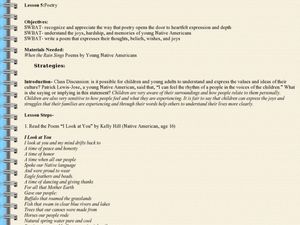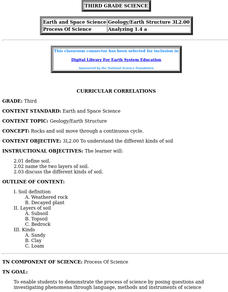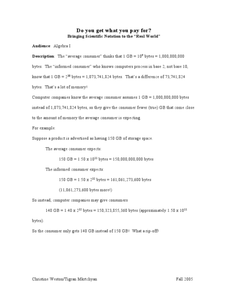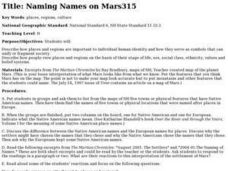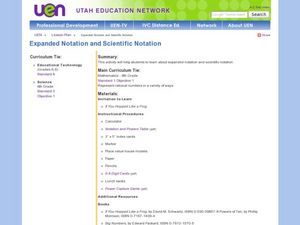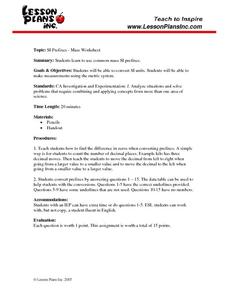Curated OER
Telling Time
Young learners participate in activities which help them understand analog clocks, and the vocabulary of telling time. They examine the values of the intervals of minutes and hours by making a human clock.
Curated OER
Poetry: When the Rain Sings Poems by Young Native Americans
Poetry can express feelings, values, and culture; it also provides insight into a time and place. Young analysts discuss the meanings of several poems from a collection of Native American works entitled, When the Rain Sings. They then...
Curated OER
Centers of the Storm: The Lyceum and the Circle at the University of Mississippi
Greek Revival architecture and the Civil Rights Movement? Sure! Examine how the Lyceum and Circle, two historic buildings located on the campus of the University of Mississippi, relate to integration and the 1962 riot on the university...
Curated OER
Acceleration of Gravity with Pendulums
High schoolers explore, analyze and study to see whether the length of a pendulum affects its period and whether the mass of a pendulum affects its period. They review and discuss a lengthy list of math definitions and experiment with...
Curated OER
Two-Point Perspective
Seventh graders will learn to create the illusion of depth on a two dimensional surface using the technique of perspective.Analyze famous works of art and photographs of local architecture and identify how each is using perspective....
Curated OER
Whole Numbers
A game is a great way to learn. Study what makes an integers, their traits, and characteristics. This lesson includes 3 separate activities intended to promote an understanding of integers, whole numbers, and opposites. The class is...
Curated OER
1846: Portrait of America in the Time of Don Pasquale: An Historic Look at American Life During the 1840's
Students construct an historical timeline extending from 1840-1850. They discuss various people, places, and events on their timelines.
Curated OER
Chess Math
Students review angles. In this geometry lesson, students become chess players on a floor chess board. When they make a move, they need to identify the angle of their movement. In the lesson plan it says the "degree" of the angle,...
Curated OER
Four Folk Tales About HYO: The Confucian Tradition of Filial Piety
Learners explore the nuances of Confucianism. In this Korean society lesson, students complete jigsaw reading assignments on the Hyo. Learners compare their own reverence for parents to that described in the pieces about Korea.
Curated OER
Curricular Correlations
An interesting lesson on different types of soils is here for you. In it, learners discuss what soil is, and consider three piles of soil - clay, sand, and loam. During the rest of the lesson, third graders discover all sorts of...
Curated OER
Clifford Goes to School and So Do We!
Students use the story, "Clifford Goes to School," to investigate the value of rules as a means of keeping them safe. Following step-by step directions, the rules are placed on patterns and which are worn home.
Curated OER
Snack Smart Move More
Show your kids that staying healthy is the smart choice! They examine nutrition, healthy snacks, and the importance of staying active in a several-part lesson plan. There are different ideas for older and younger students here, and you...
Curated OER
Do You Get What You Pay For?
Consumers explore scientific notation as it relates to the real world. In this algebra lesson, mathematicians convert Gigabytes in to scientific notation to see if they are being cheated. They differentiate between base ten and base of...
Curated OER
Up and Atom
"Up and Atom" is a mini-unit introducing middle-schoolers to the wonders of elements. Participants draw atom models, examine the periodic table, compare samples of metals to nonmetals, identify unknown elements, and more! The beginning...
Curated OER
Character... My Foundation
Students participate in a lesson examining the concept of character and how it is the foundation of lasting human relationships. They examine character traits that are considered positive and then define the differences between...
Curated OER
Reporting on the 1920s
Use this roaring 1920s history lesson to have young writers research primary and secondary sources. They use their research to examine the events or famous public figures of the time period. Next, they imagine they're in the 1920s and...
Curated OER
Money - Using R & R to Teach Mathematics
Second graders count up coins of money that add up to one dollar. In this money lesson plan, 2nd graders also spend money and keep track of how much they have spent.
Curated OER
Delayed Gratification
Word problems are great for engaging critical thinking skills, and word problems involving money increase a child's financial literacy. Boost your critical and financial thinkers with a multi-step word problem involving money and problem...
Mr. Roughton
Pawn Stars: Africa
What element was worth more during the growth of empires in West Africa: gold or halite? After examining various pieces of evidence of primary and secondary source documents placed around the room, your class members will each make a...
Curated OER
50 State Quarter Game
Students, using their knowledge of place value and number sense, play this counting game in small groups, or as a whole class, to see who be the first person to reach 50 cents.
Curated OER
Naming Names on Mars
Learners examine maps of New Hampshire to determine town and physical features that have Native American and European names. They discuss the reasons for these names to determine what influences the naming of places. They name geographic...
Curated OER
Represent Rational Numbers
Pupils identify expanded notation and scientific notation. In this rational numbers instructional activity, students use a calculator to discover the powers of 10. Pupils practice writing numbers in expanded notation using powers of 10....
Curated OER
SI Prefixes and Mass
In this SI prefixes and mass worksheet, students are given measurements of mass and they covert to the given measurement by moving the decimal the proper number of places to the left or right.
Curated OER
Break the Code!
Seventh graders crack a code using binary numbers. In this technology lesson, 7th graders explain how binary codes can represent letters and numbers. They create their own code and exchange them with their classmates.



